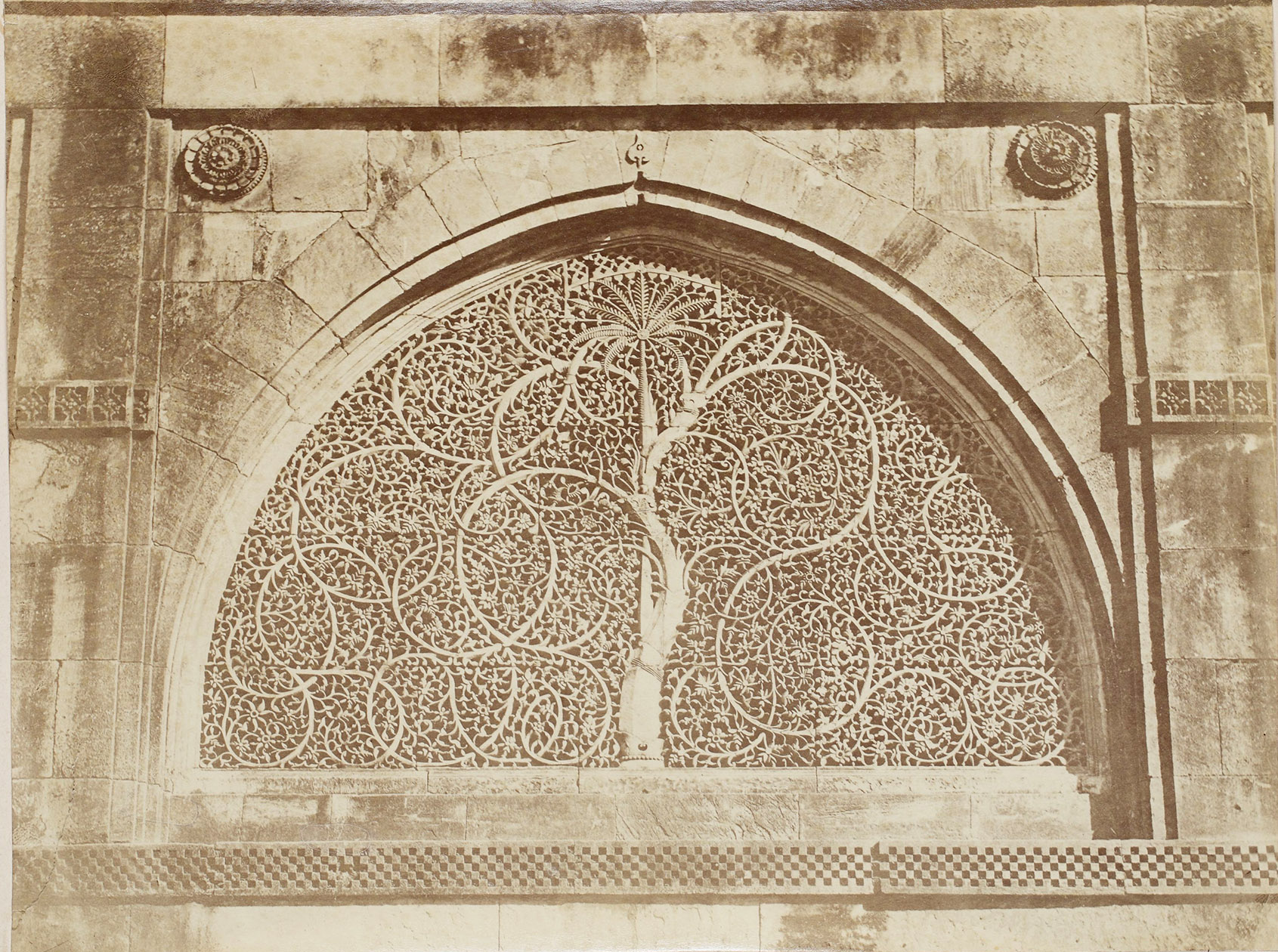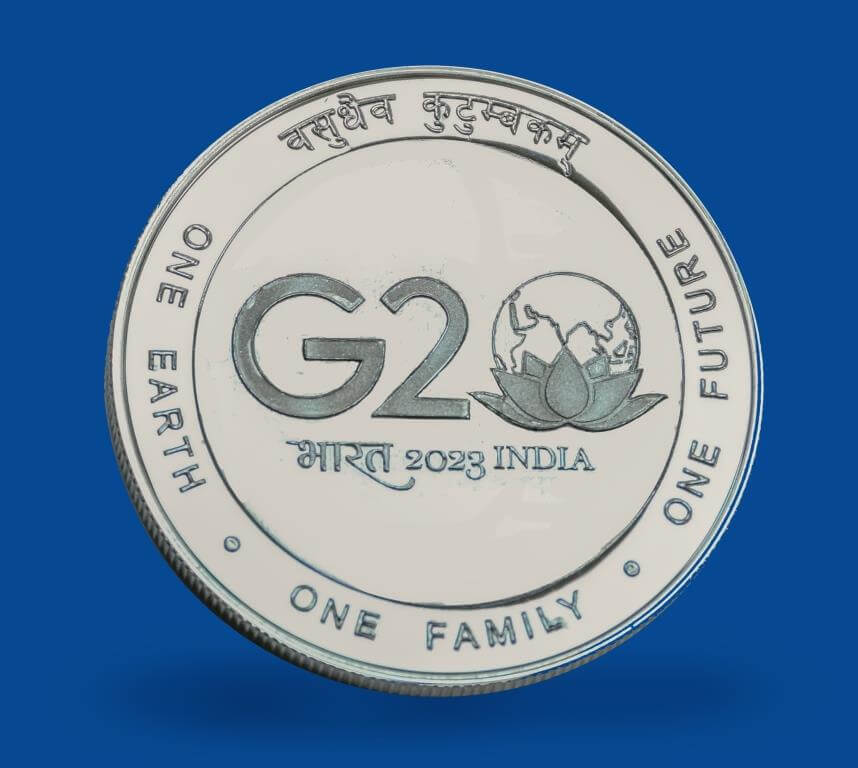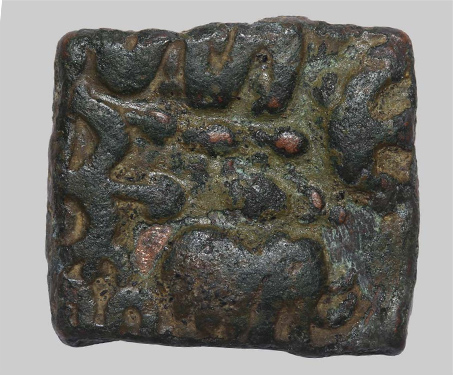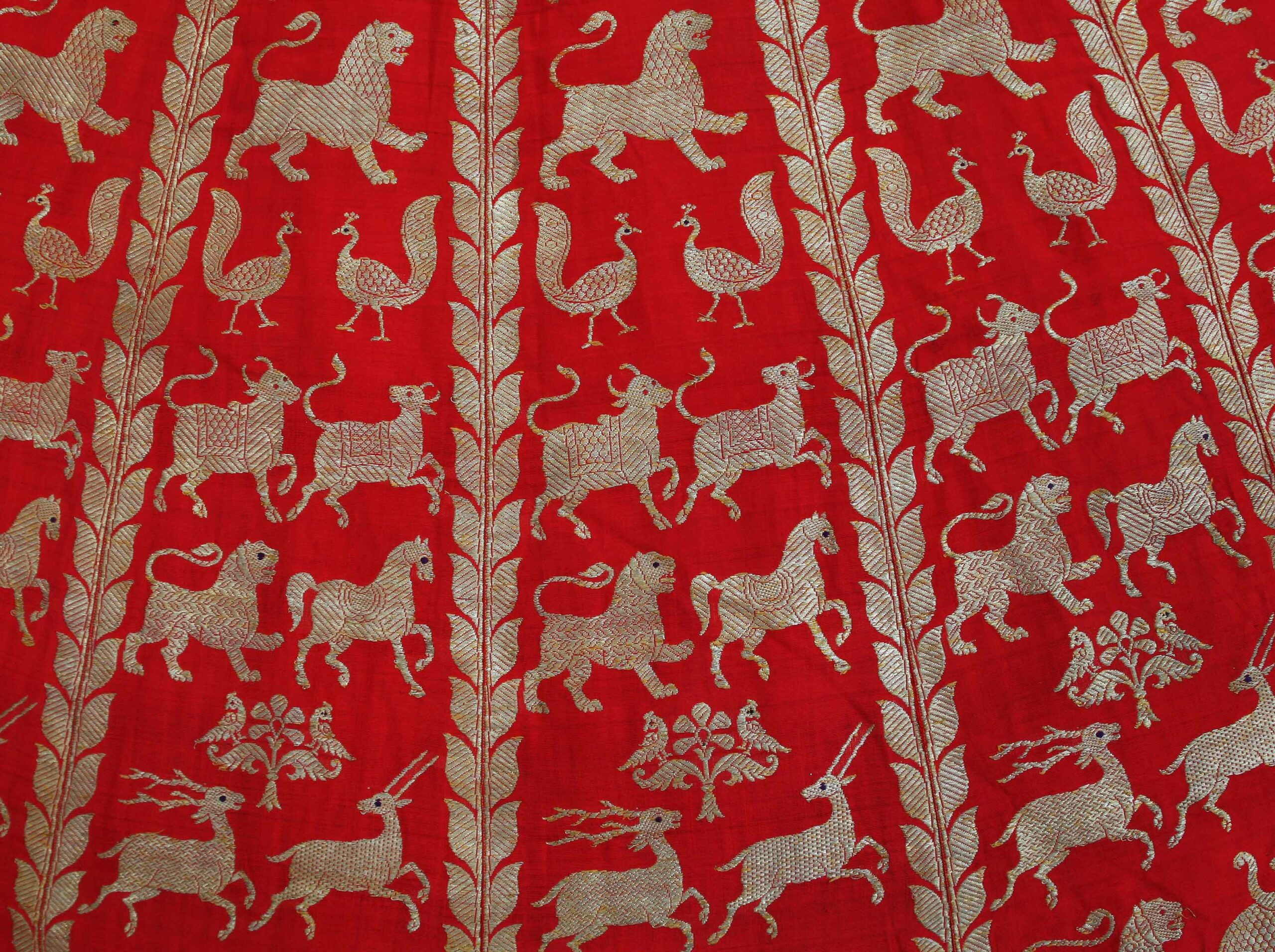
Swatch of Asavali brocade from a ghaghra (ladies’ skirt), worn by relatives or other minor royalty, Kutch, Gujarat ©️ TAPI Collection
The textiles that make up the tapestry of Gujarat have been used to cover bipeds and the four-legged, cushions and mattresses, shrines and prayer beads. While ghagras, cholis, and saris have been painstakingly filigreed out of thread, jhablas (tunics), ijars (pyjamas), patkas (sashes), kors (borders), shawls, topis, chaklas (hangings), chandarvos (canopies) and tomb covers have received the same attention to detail. One of the most important textile collections in the country is Textiles and Art of the People of India (TAPI), established by Praful and Shilpa Shah of Garden Silk Mills in Surat. It is also home to some of the lesser-known textile traditions of Gujarat.
Shilpa Shah says, “Gujarati textiles are an offshoot of several variables that were to Gujarat’s advantage. The geographic location provided full-coast access to the western Arabian Sea, and Siam, Malay countries, Java and Sumatra (on the other side). Because of its proximity to Central Asia, Persia, and Uzbekistan, there was an influence of Islamic culture, which was absorbed and vernacularised, indigenised, and internalised, and something new came out of it.”
When the Gujarat Sultanate period began (1206-1526), a culture of producing prestige textiles such as gifts and ‘khilats’ robes of honour, also became the norm. “Social groups were another important contributor,” says Shah. “We call them castes, but the various social groups of Gujarat had their own sartorial identity. That probably became diluted when the British ruled us, but we know that even until the 1980s — the Jats, Ahirs, Maldharis, Meghwals, Rabaris — dressed in their own distinct way.”
Supporting the textile trade was a network of entrepreneurs. “This is where management is really seen at a minute level,” continues Shah. “These surnames, with some connection to a textile process, continue to exist: Ruwala, Sutaria or Sutarwala (yarn); Rangaari (dyer); Mashruwala; Reshamwala; Gajiwala (satin); Jariwala (metal-wrapped yarn); Kapadia and Doshi (cloth merchants), Unwalla (wool trader); and chippas (dyers/printers). Then, there were the bankers, Nanavati and Shroff; the brokers were adatiyas with surnames such as Dalal; angadias were the carriers.”
Shah shares with Sarmaya some stunning textiles from the TAPI Collection and explains the historical and cultural significance of each distinctive art form.
Gara embroidery
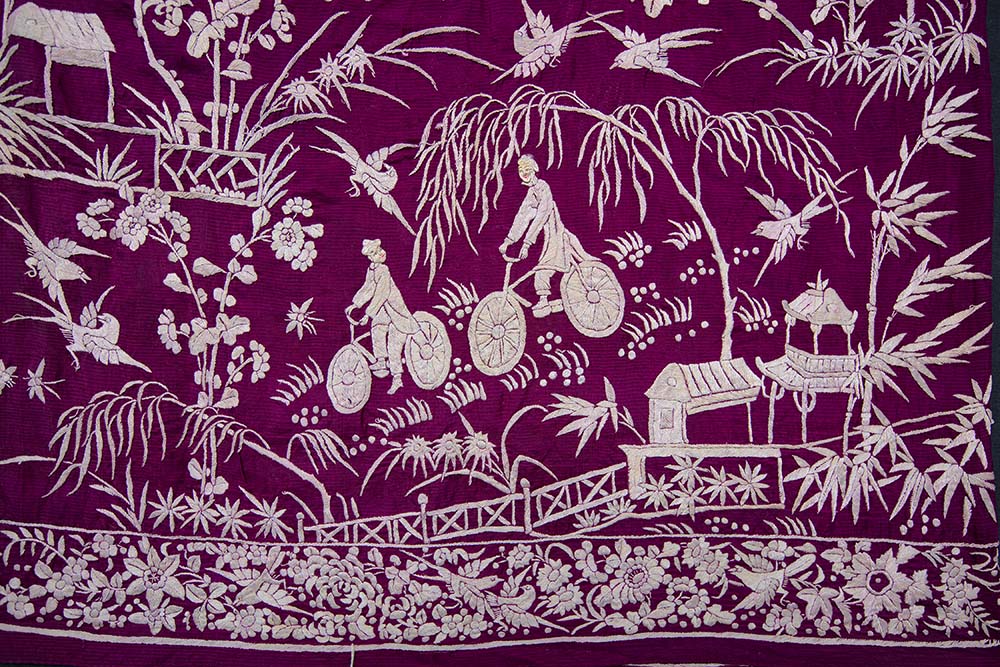
Close-up detail of a Parsi Jhabla or vest ©️ TAPI Collection T.22.06
Patronised by the Parsi community, gara was a style of embroidery initially imported from China, which gained wider acceptance due to the deepening trade links. In ‘Peonies and Pagodas: Embroidered Parsi Textiles’, co-edited by Shilpa Shah and Tulsi Vatsal, the latter writes, “In the late 1700s, a triangular trade was developed when Indian cotton was sold to China, the proceeds were used to purchase tea, which were then exported to Britain. Opium gradually became part of this three-cornered trade.” Hirji Jivanji Readymoney was recorded to be the first Indian Parsi to have made the journey to Canton in 1756. By the mid-19th century, a preference for China-made silks and Chinese embroideries was seen among Parsi fashionistas. “Even the West was going through this craze for oriental design, such as the chinoiserie movement,” says Shah. It did not take long for embroidered garas and jhablas in the Chinese style to be made in Surat to cater to the demand from well-heeled Parsi families in Mumbai and other towns.
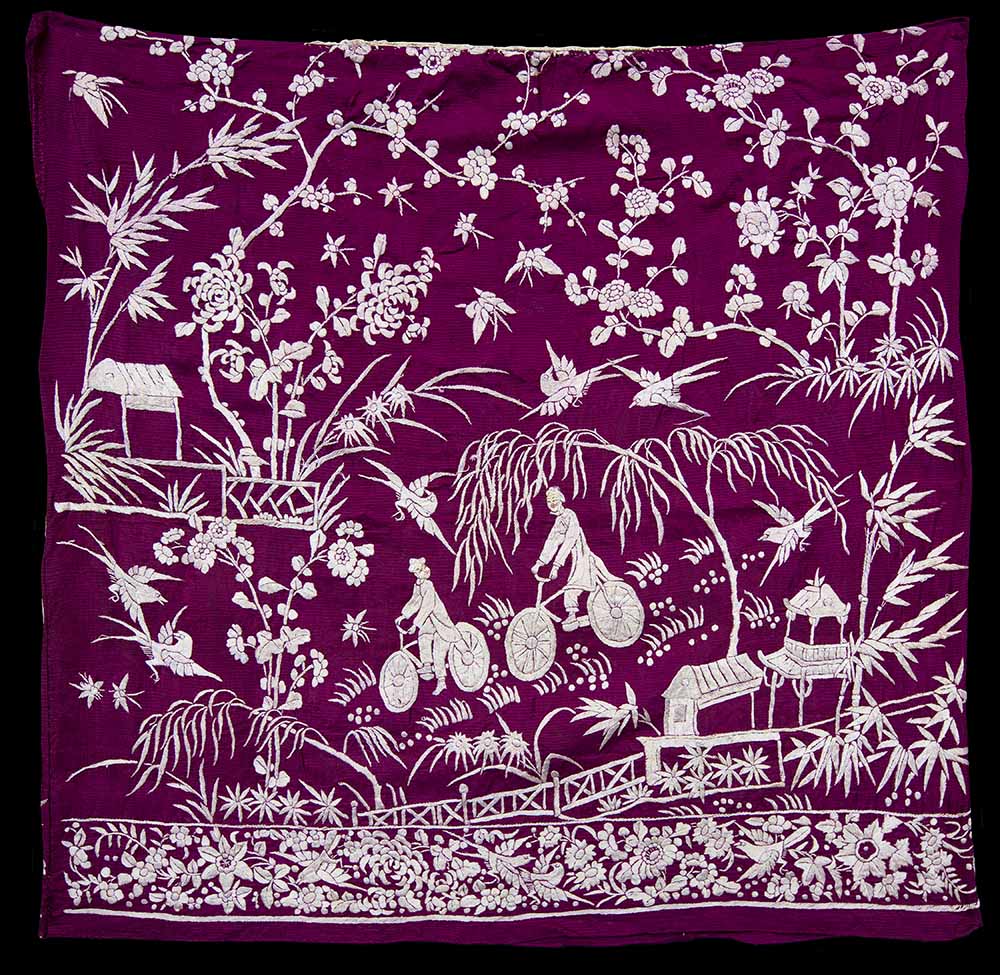
Parsi Jhabla ©️ TAPI Collection T.22.06
Chinese motifs of pagodas, pavilions, bridges, peonies, bamboo, peacocks, and phoenixes, executed mainly in white on brightly coloured silks, were popular. Describing a jhabla, seen here, Shah says, “It shows two men riding bicycles. Thinking of the design and when this piece might have been made, we know bicycles reached China in about 1889 and that the last emperor, Puyi, took such a fancy to it that he imported one and used it often. The sing-song girls (courtesans), who were not inhibited by the social mores of their time, would ride them. There were two American students in 1899, who left Washington University, and decided to travel on cycles to see the world. When they reached China, you can imagine the stir they caused. As they went through villages, people would come to see them in throngs.”
Tanchoi weave
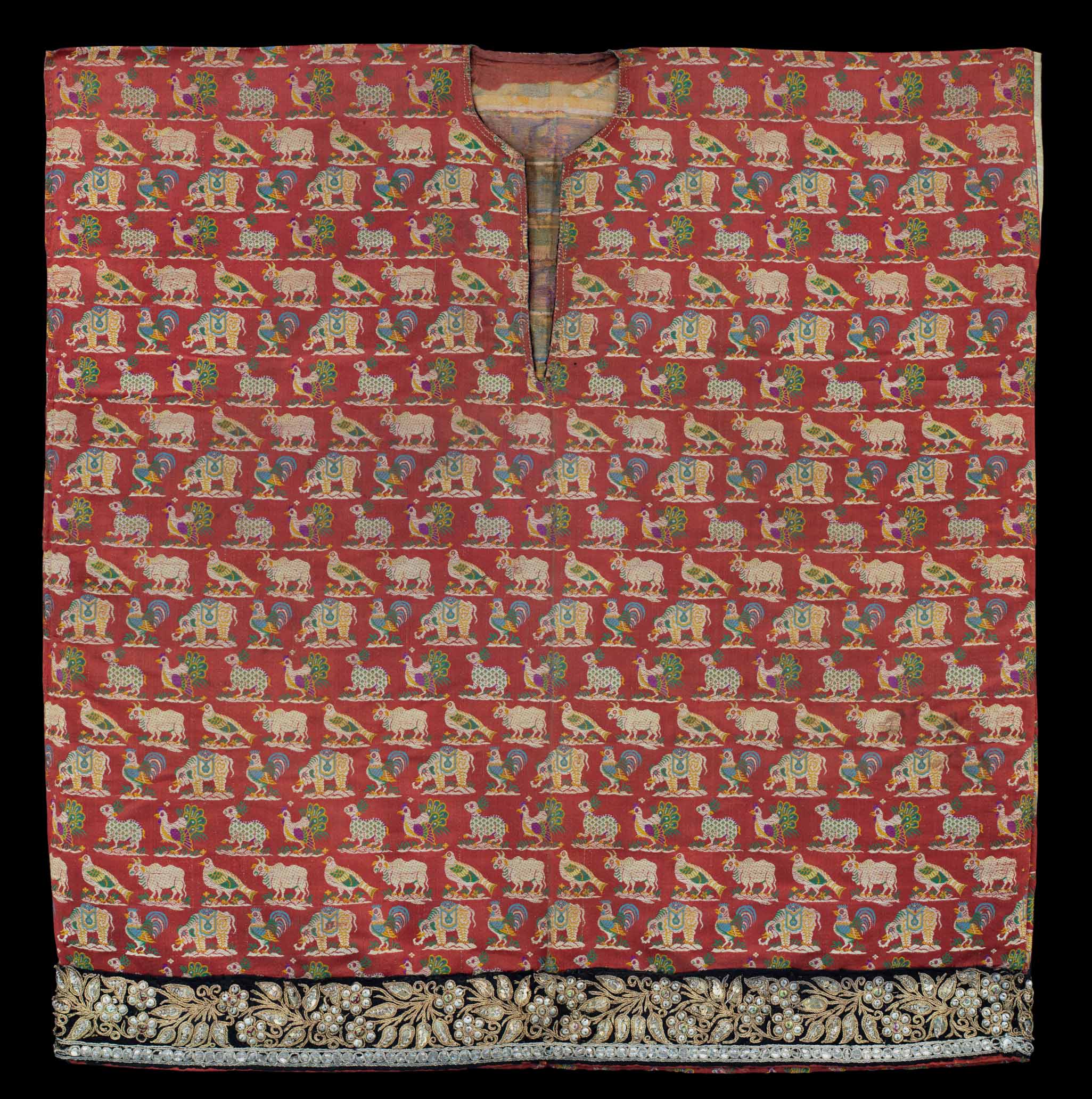
Tanchoi jhabla ©️ TAPI Collection T.22.07 (5)
Parsis became master weavers of tanchoi, which acquired its name from the three (‘tran’) ‘Choi’ brothers of Surat, who sailed to China to learn this art from the master weaver, Choi. While pointing to a jhabla in tanchoi, Shah says, “When there is ornamentation or figurative motif on a textile, they have to create an extra supplementary weft. In the tanchoi, the background is always satin, and so it has a sheen like mashru. But, an extra weft would leave a float in the back. The different coloured wefts in the tanchoi are completely bound in, so there’s no float on the reverse. The design of this particular tanchoi jhabla echoes the export ceramics of the China trade; the fauna resemble their ceramic counterparts. The base of these figures, the mounds, indicate they were copied from ceramic sculptures of pachyderms, roosters, and rabbits. But, the weavers have also introduced Indian motifs of bulls, parrots, and peacocks. So, it’s a bit of an amalgamation of designs. Generally, figurative motifs in tanchoi are chakla-chaklis (pairs of birds) and flowers, which makes this a very unique design.”
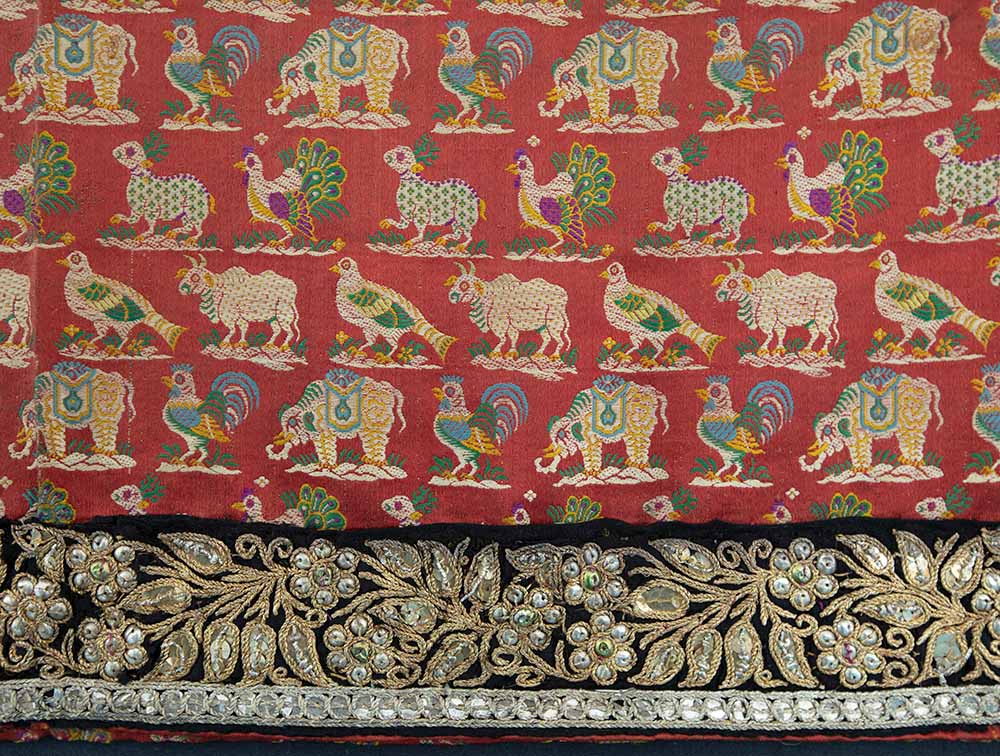
Close-up of Tanchoi jhabla ©️ TAPI Collection T.22.07 (5)
Brocades and Ashavali
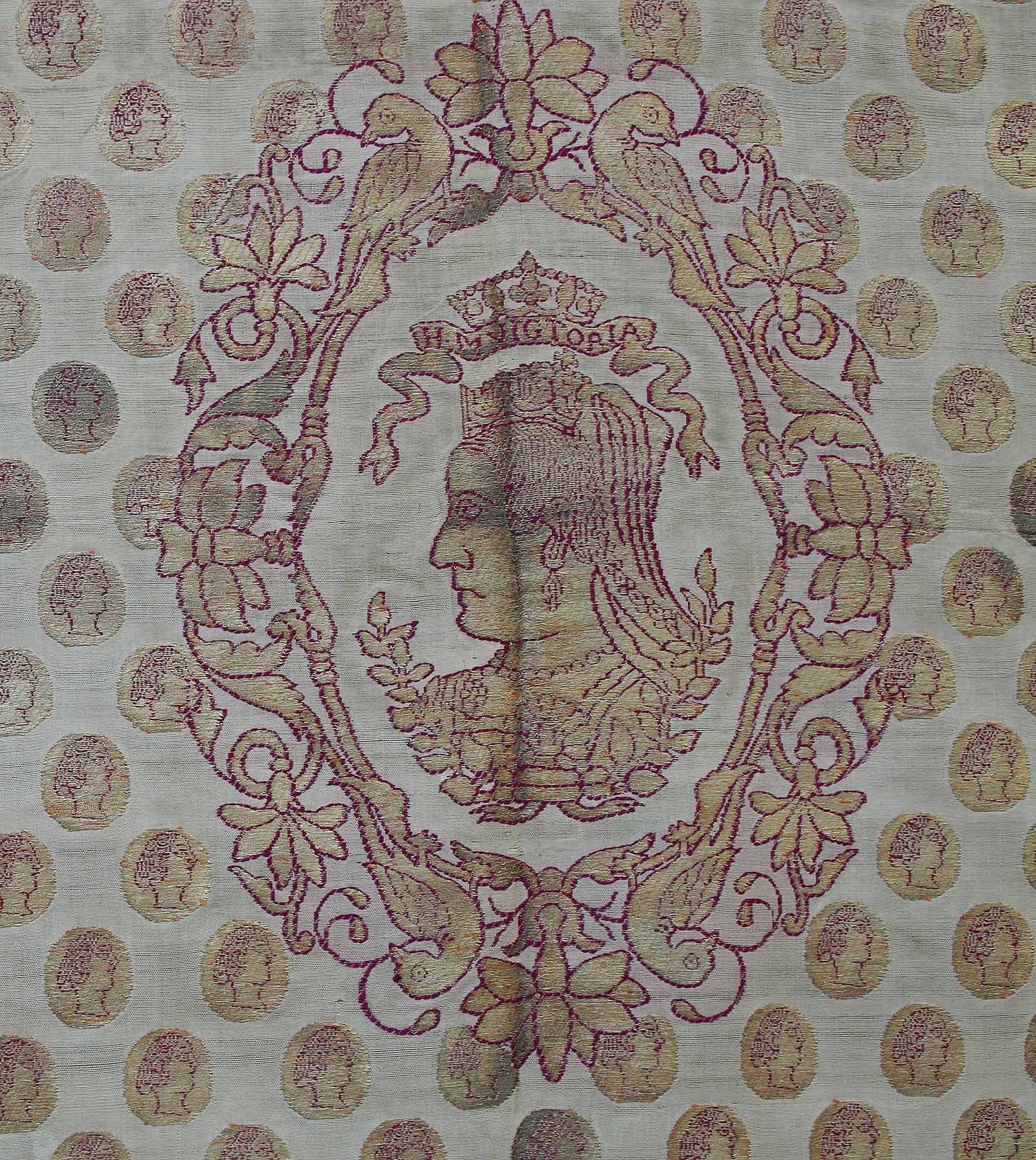
Central motif of Queen Victoria rumaal, brocade woven with gold zari, 19th Century ©️ TAPI Collection T.08.102 (3)
“Brocaded textiles were the quintessential ‘status cloths’. Historically, Gujarat took the lead in making these for royalty and aristocracy, thanks to the influence of Persian craftsmen. Later, brocades were produced in other centres in the country ,” says Shah, “It is said that following a series of famines, Gujarati weavers migrated to Benaras. Weavers of Varanasi are probably the most skilled weavers on the planet today. There’s nothing they cannot do. They can copy a Paithani or a Baluchari, they know the art of the jala and the jangla. So, they understand the loom and the variations it is capable of.”
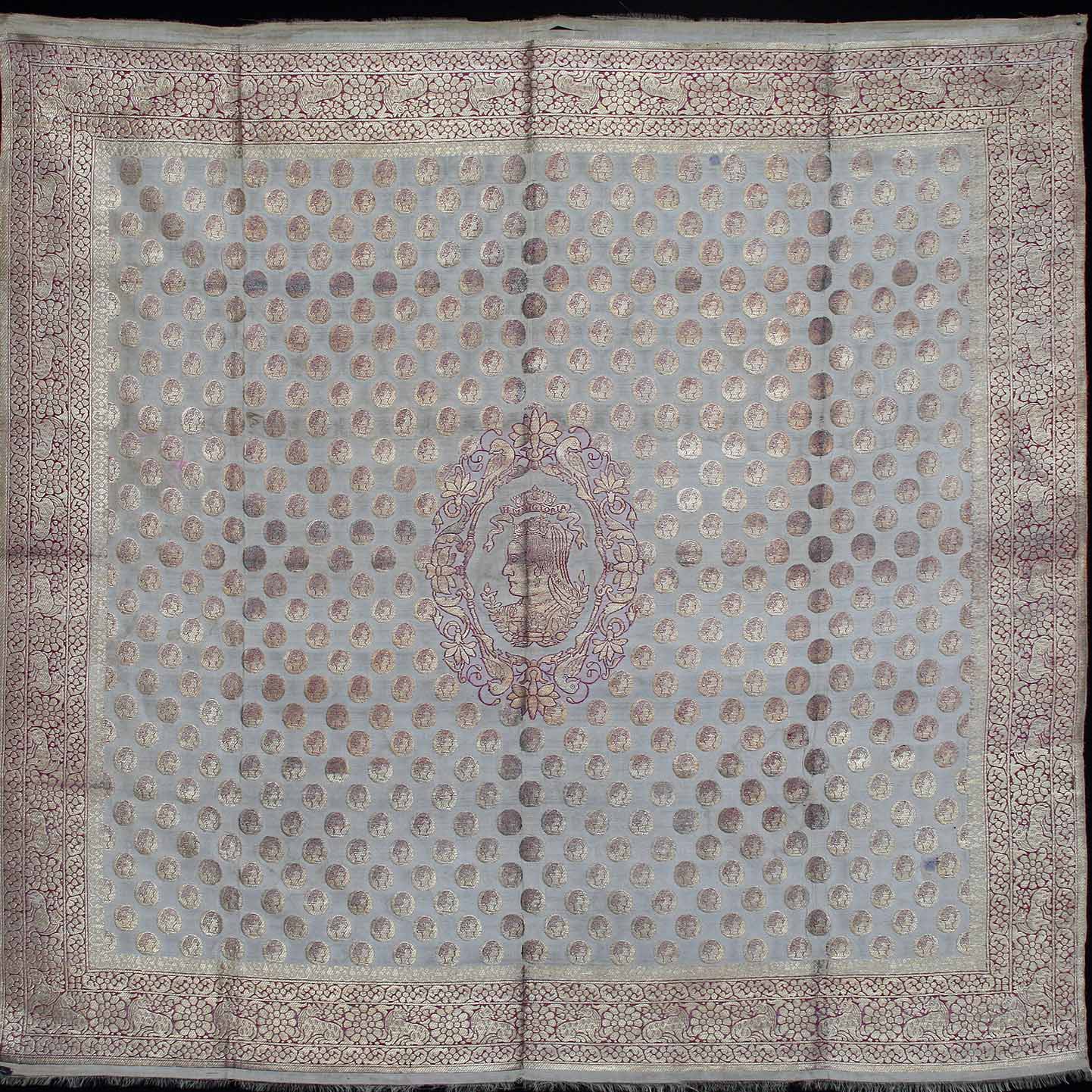
Queen Victoria rumaal, brocade woven with gold zari, 19th Century ©️ TAPI Collection T.08.102 (3)
Brocades woven in the region of Ahmedabad were called Ashavalis. “But, there were brocades made in Surat as well,” she says. “This is a chandarvo with a portrait of Queen Victoria as the central medallion, and small busts woven all through.” A piece from 19th-century Gujarat, “It must have been especially made for a patron who was commemorating the Queen, or was presenting it to one of the officers of the East India Company. The zari weft is executed in a twill weave, hence the motifs appear embossed, giving them an enamel effect. The ganga-jamuni combination of gold and silver was very popular.”

Parsi Ashavali jacket and topis (hats) embroidered with the names of the wearer. Hats, from top to bottom: Baronet Sir Jamsetjee Jeejeebhoy’s topi, front and top view; Furdunjee Cursetjee Paruck’s topi ©️ TAPI Collection
“The personalised topi is very interesting: it has the inscription of Furdunjee Cursetjee Paruck (sic). He owned ships and used to trade with China. A good friend of Jamsetjee Jejeebhoy, they had identical topis made, probably from the same workshop, and around the same time. It includes Jamsetjee’s title of ‘Baronet Sir Jamsetjee Jejeebhoy’.
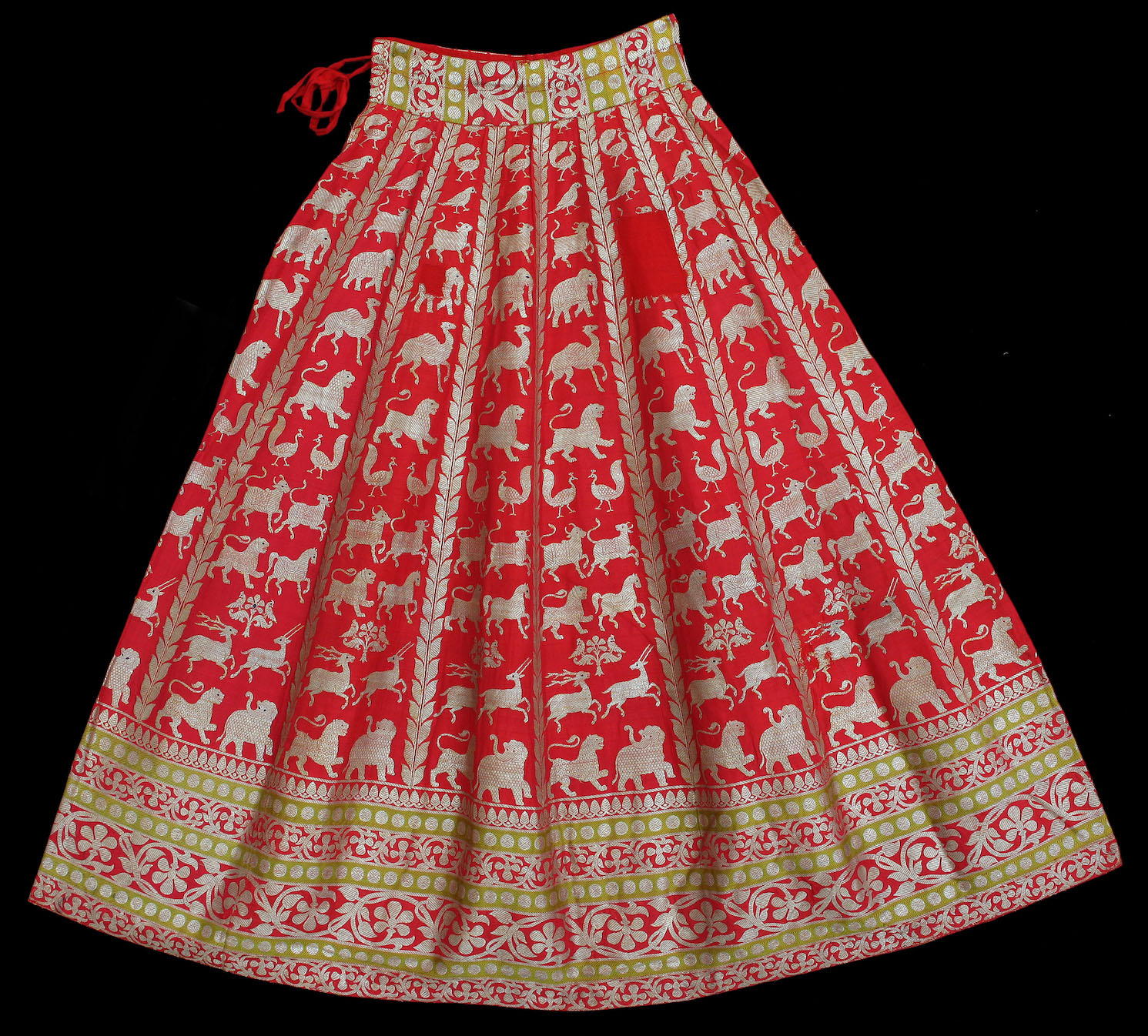
Asavali brocade ghaghra (ladies’ skirt), Kutch, Gujarat ©️ TAPI Collection T.00.141
“This Ashavali ghagra was painstakingly done, because the weaver could have repeated the same motifs to save time and effort, but he did not. The elephant, deer, lion, and peacocks appear on alternate panels created in a ‘kali’ gradient, so the flared drape makes it figure- flattering.”
Mochi embroidery
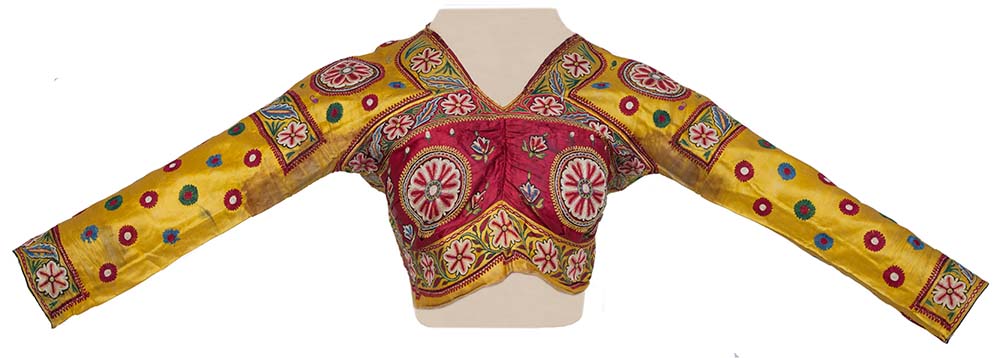
Mochi-work on a Maharani’s choli ©️TAPI Collection
In ‘The Shoemaker’s Stitch: Mochi Embroideries of Gujarat’, co-authors Shah and Rosemary Crill write that Mochi embroidery was “a class of exquisite, regional stitch craft known as mochi-bharat. Belonging to the humble shoemaker community of Gujarat, they were unrivalled professionals of chain-stitch embroidery”.
With origins in Sindh, no one clearly knows when shoemakers started embroidering on cloth rather than leather. One account states “that the transfer of knowledge from Sindhi to Kutchi craftsmen occurred during the reign of Maharao Desalji of Kutch (r 1718-41)”. As such, “some of the most familiar examples of fine Mochi work are the superbly embroidered garments worn by women of the royal and wealthier classes of Kutch…Under Maharao Lakhpatji’s long reign (r 1741-1780), indigenous arts and decorative crafts received an enormous boost”.
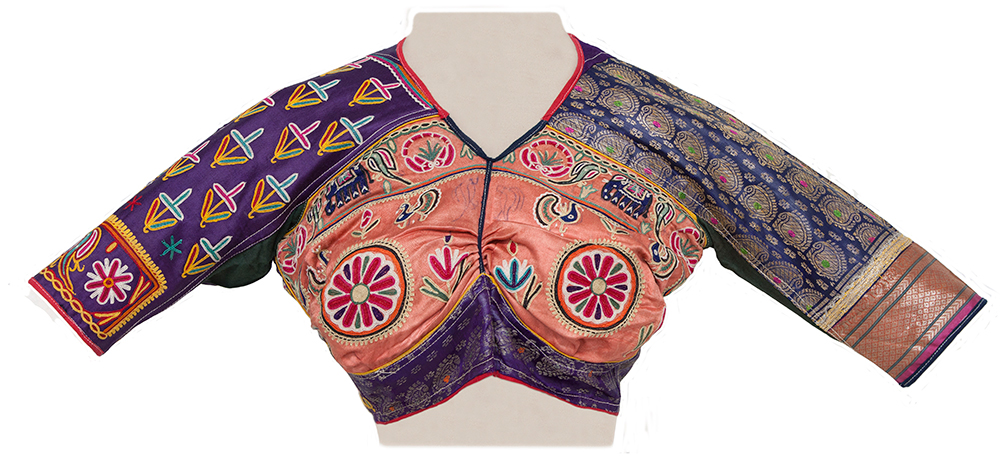
Choli with asymmetrical sleeves ©️TAPI Collection
While pointing to a blouse in Mochi, Shah says, “This belonged to a lady of the royal family of Kutch, because according to custom, only royalty could wear cholis with symmetrical sleeves. Other aristocratic ladies would wear cholis with one sleeve embroidered in Mochi stitch and the other could be brocade. This fashion was carried forward in Saurashtra.”

